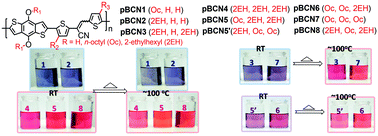Polymer side-chain substituents elucidate thermochromism of benzodithiophene–dithiophenylacrylonitrile copolymers – polymer solubility correlation of thermochromism and photovoltaic performance
Abstract
Nine pBCNx polymers based on a donor–π-acceptor benzo[1,2-b:4,5-b′]dithiophene-(E)-2,3-di(thiophen-2-yl)acrylonitrile main-chain structure and n-octyl/2-ethylhexyl as the side-chain substituents have been designed and synthesized. The thermochromism of the pBCNx polymers has been carefully examined in both solution and the thin-film state. With additional evidences from Raman spectroscopy and AFM microscopy, we have deciphered the varied colours of nine pBCNx polymers in solution and the pronounced thin-film thermochromism only observed for certain pBCNx polymers, i.e., pBCN4, pBCN5, pBCN6, and pBCN8. The alkyl side-chain, and hence the solubility or aggregation of pBCNx polymers, is a main factor of the varied colour in solution and the varied thermochromism in the thin film. We have identified that a stronger main-chain and main-chain interaction are present on the (E)-2,3-di(thiophen-2-yl)acrylonitrile moiety, whereas the poor to moderate solubility pBCN3, pBCN5′, and pBCN7 exhibit pronounced thermochromism in solution, and pBCN4, pBCN5, pBCN6, and pBCN8 are four polymers which have good solubility in solution and show thermochromism in the thin-film state. We took navy blue pBCN3 (poor solubility), magenta pBCN4 (good solubility), and reddish purple pBCN5′ (moderate solubility) for the fabrication of bulk heterojunction organic photovoltaics (OPVs). With a solvent annealing treatment, the power conversion efficiency of the OPVs has been improved significantly from 4.7% to 6.2% for the good solubility pBCN4, but there is little and no improvement for the moderate solubility pBCN5′ and poor solubility pBCN3, respectively. Our study verifies that the good OPV performance of the pBCNx polymers can be correlated to the pronounced thin-film thermochromism. A good solubility of the polymer is a common characteristic of a material with significant thin-film thermochromism and good OPV performance.



 Please wait while we load your content...
Please wait while we load your content...